|
Psalters, and Bible Pages (Leafs) Antique Bibles to 1599 | This page: Bibles 1600 to Present | 
|
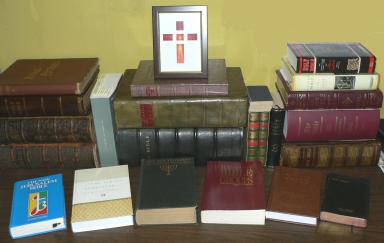 The antique and historic Bibles, Psalters, and pages (leafs) below are in my small but growing collection. They are NOT for sale, although I have listed the price I paid for reference purposes. Many of them represent important and/or notable versions or printings. About one-half are in English, while others are in Hebrew, Latin, Coptic, German, French, Italian, Swedish, Ge'ez, Arabic, and Slavionic. Many significant translations are represented such as Jerome, Wyclif, Tyndale, Coverdale, Geneva, Taverner, Bishops, Luther, KJV, Douay-Rheims, Latina, Le Sainte, and others. Also listed are psalters, books of illustrations, and church documents. Click on any image for a super-sized image of the item.
The antique and historic Bibles, Psalters, and pages (leafs) below are in my small but growing collection. They are NOT for sale, although I have listed the price I paid for reference purposes. Many of them represent important and/or notable versions or printings. About one-half are in English, while others are in Hebrew, Latin, Coptic, German, French, Italian, Swedish, Ge'ez, Arabic, and Slavionic. Many significant translations are represented such as Jerome, Wyclif, Tyndale, Coverdale, Geneva, Taverner, Bishops, Luther, KJV, Douay-Rheims, Latina, Le Sainte, and others. Also listed are psalters, books of illustrations, and church documents. Click on any image for a super-sized image of the item.The Second Edition of the Catholic New Testament in English
“The New Testament of Iesvs Christ faithfully translated into English” by the English College then Resident in Rheims, France. Set forth the second time, by the same College now returned to Douay.
The Second Edition of the Roman Catholic New Testament in English first printed at Rheims in 1582 marked a profound departure from keeping the scriptures in a Latin tongue. Printing in English was not out of conviction, but of necessity in response to the availability of the Geneva Bible, with its strongly Protestant notes. In some ways this Roman Catholic translation of the New Testament is parallel to the Protestant Geneva Bible, for both of them were produced by religious refugees who carried their faith and work abroad. Since the English Protestants used their vernacular translations, not only as the foundation of their own faith but as siege artillery in the assault on Rome, a Catholic translation became more and more necessary in order that the faithful could answer, text for text, against “the intolerable ignorance and importunity of the heretics of this time.”
This first Roman Catholic translation was rendered into English from the Latin Vulgate by Gregory Martin, under the supervision of William Allen (later Cardinal Allen) and of Richard Bristow. According to the Douay Diaries, Martin began the translation in October 1578 and completed it in March 1582. The translation adheres very closely to the Latin, though it shows traces of careful comparison with the Greek. But its groundwork was practically supplied by the existing English versions, from which Martin did not hesitate to borrow freely. In particular there are many striking resemblances between Martin’s renderings and those in Coverdale’s diglot of 1538.
Further, by a principle first enunciated by Stephen Gardiner, almost the last Roman Catholic Bishop of Winchester, and Mary’s chancellor, technical words were transliterated rather than translated. Thus many new words came to birth in this work. Many of these words now seem familiar enough to us, such as evacuated, gratis, holocaust, victims, not to mention that most Protestant of words, evangelize.
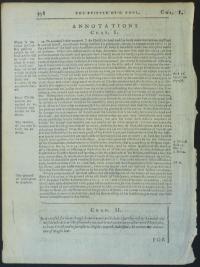
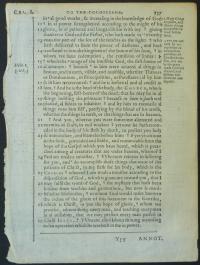 The Rheims New Testament exerted a very considerable influence on the King James version of 1611, transmitting to it not only an extensive vocabulary, but also numerous distinctive phrases and turns of expression. This edition incorporates several significant changes, including a new Approbations and Explanatory Notes, and the addition of “A Table of Heretical Corruptions” of the Biblical text.
The Rheims New Testament exerted a very considerable influence on the King James version of 1611, transmitting to it not only an extensive vocabulary, but also numerous distinctive phrases and turns of expression. This edition incorporates several significant changes, including a new Approbations and Explanatory Notes, and the addition of “A Table of Heretical Corruptions” of the Biblical text.The first edition of 1582, of which the 1600 edition is a close reprint, is quite rare; a third edition was produced in 1635, but it would not be until the Challaners revision appeared in 1728 that the Rheims New Testament would be again printed. The Old Testament would not be available in an English Catholic translation until the Douay version of 1610 was issued.
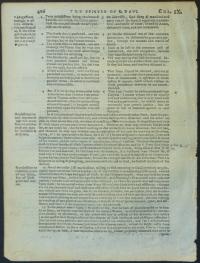
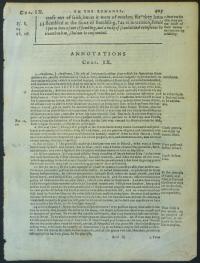 Leaf, 1600 Douay Catholic Bible. English. Colossians 1:11-29, pages 537-38, with extensive annotations (commentary). Printed by Daniel Veruliet, Antwerp, 6.2" x 8.3” ($8.00)
Leaf, 1600 Douay Catholic Bible. English. Colossians 1:11-29, pages 537-38, with extensive annotations (commentary). Printed by Daniel Veruliet, Antwerp, 6.2" x 8.3” ($8.00)Scripture text in 10-point Roman type, single column, 40 lines with sidenotes and annotations in closely-spaced 8-point type. (Herbert 258)
Leaf, 1600 Douay Catholic Bible. English. Romans 9, pages 405-06, annotations (commentary). Printed by Daniel Veruliet, Antwerp, 6.2" x 8.3” ($4.00)
In this Bible, a lengthy section of “Annotations” (commentary) follows each chapter of scripture. Interestingly, even the annotations have sidenotes. Single column of 68 lines in closely-spaced 8-point type. (Herbert 258)
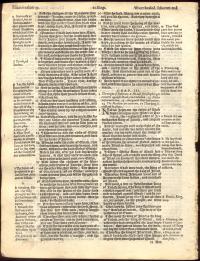
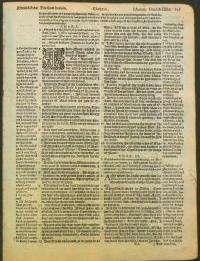 Leafs, 1602 Geneva Bible, English, 2 Kings 1:1 - 3:10, OT page 145. Printed by Robert Barker, London. 196 x 138, 6.4" x 8.4" ($3.50)
Leafs, 1602 Geneva Bible, English, 2 Kings 1:1 - 3:10, OT page 145. Printed by Robert Barker, London. 196 x 138, 6.4" x 8.4" ($3.50)The Geneva Bible, the work of reformers who fled from England to Geneva during the reign of Queen Mary was highly influential for the next 100 years, especially for Puritan England and the U.S. In competition with the Bishop’s Bible and later, the KJV, the Geneva Bible appeared in at least 144 editions by 1644.
Printers like Christopher Barker, Robert Barker, and their associates reprinted the quarto edition of 1580 at least 36 times to meet the demand so only if you have the original title page can you identify which version a leaf is from. The type dimensions indicate this page is from a 1602 edition. Printed in 9-pt black letter, double column, 71 lines per column. Sidenotes and commentary in 7-pt Roman type; chapter summaries in tiny 6-pt italics. [Herbert 269]
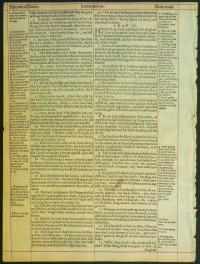
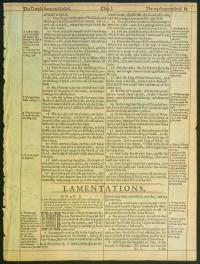 Leaf, 1606 Geneva Bible. Jeremiah 52:11 - Lamentations 2:13. Printed by Robert Barker, London. 197 x 135, 6.2" x 8.3" ($8.50)
Leaf, 1606 Geneva Bible. Jeremiah 52:11 - Lamentations 2:13. Printed by Robert Barker, London. 197 x 135, 6.2" x 8.3" ($8.50)Though never officially adopted, the Geneva version was the standard English translation for three generations, familiar to Shakespeare, Bunyan, and the soldiers of the English Civil War. Thus it is of cardinal importance for its influence on English literature, language, and thought.
Up until the turn of the 19th Century, men went around in horse drawn carts collecting bones and rags (cloth). The bones were used to make glue and the rags were used to make pages much as wood pulp is used today. They earned the nick-name “rag and bone men.” Leaves made in this way can actually be ironed (carefully)!
This leaf is from one of many reprints of this edition. Printed in small 7-pt Roman type, double column, 72 lines, extensive tiny font sidenotes, 6-line initial capitals. Red rules added after printing for wealthy purchasers. Leaf trimmed at top. [Herbert 285]
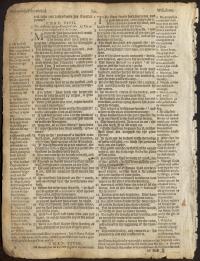
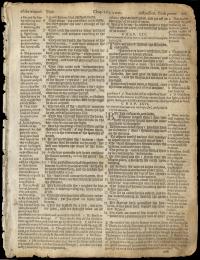 Leaf, 1608 Geneva Bible, Job 24:6 - 28:27, OT page 205. Printed by Robert Barker, London. 198 x 139, 6.3" x 8.2"($5.00)
Leaf, 1608 Geneva Bible, Job 24:6 - 28:27, OT page 205. Printed by Robert Barker, London. 198 x 139, 6.3" x 8.2"($5.00)From 1560, the Geneva Bible became the Bible of choice for over 100 years of English speaking Christians. Between 1560 and 1644 at least 144 editions of this Bible were published. The Geneva Bible was also the first English Bible to break the chapters of scripture into numbered verses, and it was the first true “Study Bible” offering extensive commentary notes in the margins.
Thirty-six nearly identical editions of this version of the Geneva Bible appeared between 1580 and 1615 printed by Christopher Barker, his deputies, and his son, Robert Barker. The type dimensions of this page indicate it is from a relatively late 1608 edition. [Herbert 294]
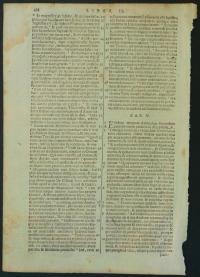
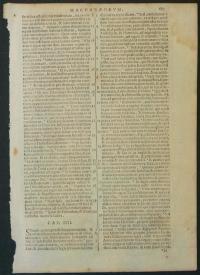 Leaf, 1608 Biblia Sacra, printing of Latin Vulgate of 1592, 2 Maccabees 3:25 - 5:10, page 687-88. Published by Iuntas(?),Venice, 4.6" x 6.7" ($6.00)
Leaf, 1608 Biblia Sacra, printing of Latin Vulgate of 1592, 2 Maccabees 3:25 - 5:10, page 687-88. Published by Iuntas(?),Venice, 4.6" x 6.7" ($6.00)The 1592 edition was the first edition of the Sixto-Clementine Vulgate which remained the official Bible of the Catholic Church until 1979. It is named for Pope Sixtus V, responsible for the original translation, and Pope Clement VIII who supervised the group of scholars who revised it. It was reprinted in 1593, 1607, 1608 (this edition), and many more times in later years.
For the 1608 edition, one source lists the publisher as Evangelistam Deuchinum, & Io. Baptistam Pulciani Socios.,Venice and another source as Iuntas, Venice.
Printed in small 7-pt Roman type, double columns, 64 lines. Continuous text (no indentation) with verse numbers on both sides of a rule down the center of the page.
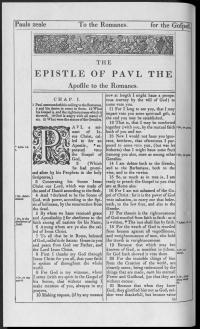
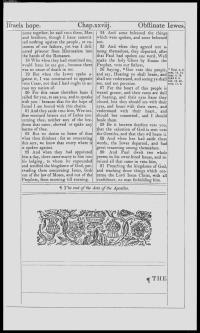 Reprint Bible, 1611 Holy Bible KJV, Printed in 2010 by Hendrickson Publishers, 5.1" x 8.2" ($14.50)
Reprint Bible, 1611 Holy Bible KJV, Printed in 2010 by Hendrickson Publishers, 5.1" x 8.2" ($14.50)Printed for 400th anniversary of the KJV, this volume includes a 23-page article about earlier English translations, an 18-page description of the 1611 version and an 8-page later history of the 1611 Bible. Word for word and page for page, the text with its original marginal notes, preface ("The Translators to the Reader"), and other introductory material appear as they first did. The sole concession to modernity is a far more readable Roman typeface set by 19th-century master printers. This reprint of the 1611 Bible has the complete OT and NT (no Apocrypha) with all seven extra sections (calendar, almanack, etc.). The original printing by Robert Barker, London, was folio size (approx 11" x 14") with black letter type whereas this edition is considerably smaller with Roman type similar to the 1612-13 quarto editions.
Printed in small 7-point Roman type, double columns, 59 lines with 5-line capitals beginning each chapter. Minimal sidenotes in tiny 5-point type.

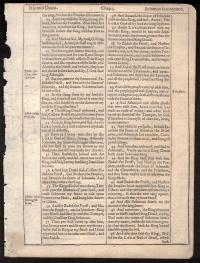 Leaf, 1613 Holy Bible King James Version, 1 Kings 1:23 - 2:18. Printed by Robert Barker, London. 204 x 140 mm (text), 6.3" x 8.5" (page).
Leaf, 1613 Holy Bible King James Version, 1 Kings 1:23 - 2:18. Printed by Robert Barker, London. 204 x 140 mm (text), 6.3" x 8.5" (page).The King James Version of the Bible, commonly known as the “Authorized Version,” was a new translation that took about 4 years to prepare. It replaced the Geneva Translation, the marginal notes of which King James felt were overly critical of the monarchy. Many expert scholars from Oxford and Cambridge were involved in this lengthy project and the result was an excellent translation that has stood the test of time.
The original printing in 1611 by Robert Barker, London, was a large folio-size version in a black-letter typeface. Later versions followed in 1612 and 1613 in Roman type on smaller size pages. In the first 1611 printings there were many printing errors throughout, but one often cited is in the book of Ruth 3:15, “and he went into the city.” The correct printing should have been, “and she went into the city.” The error was corrected in 1613 so this has become known as the “She” Bible.
In a bizarre twist, this verse has again become controversial among translators, some of whom believe (NIV, ASV, NRSV, JPS, Berean) that “he” is actually the correct word.
Quarto size, printed in 8-pt Roman type, double columns, 58 lines per column, tiny 6-pt chapter introductions in italics, minimal marginal notes in 6-pt italics and cross references in 7-pt plain type. Has borders and column rules. No page numbers. [Herbert 320 or possibly 324]
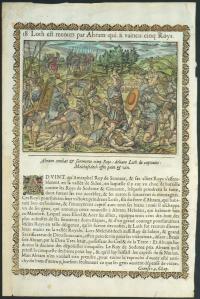
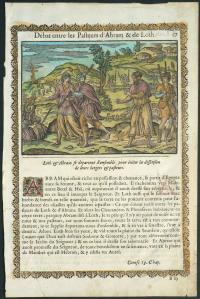 Leaf, c. 1614 La Saincte Bible, later printing, French. Genesis 13, 14. Published by Jean Le Clerc, Paris, 14.3" x 9.3" ($31.67.)
Leaf, c. 1614 La Saincte Bible, later printing, French. Genesis 13, 14. Published by Jean Le Clerc, Paris, 14.3" x 9.3" ($31.67.)Large woodcut illustration for Genesis 13 (esp 13:8) shows Abram departing from Lot so there would be no strife between Abram, Lot, and their herdsmen. The text is a summary of the chapter, not the scripture itself.
Reverse, a large woodcut illustration for Genesis 14 (esp 14:14-18), shows Abram battling and defeating five kings and, in the background, Melchizedek offering bread and wine to the victors.
Jean Leclerc (1550-1627) was the engraver as well as the publisher of these outstanding French late-Renaissance woodcuts. He was of the Venetian School and studied under the old master, Carlo Saraceni and also worked with Caravaggio.
Folio-size page of just one column, 18 lines with 4-line historiated initial. Illustration, border, and initial all colored by hand.
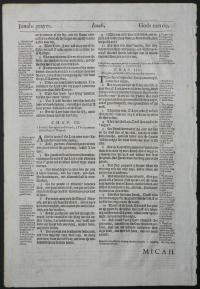
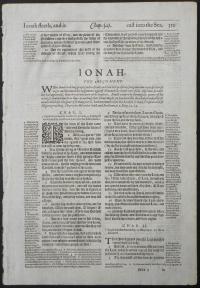 Leaf, 1616 Geneva Bible, Jonah 1:1 - 4:11, OT page 352-53. Printed by Robert Barker, London. 280 x 173, 8.5" x 12.5" ($15.00)
Leaf, 1616 Geneva Bible, Jonah 1:1 - 4:11, OT page 352-53. Printed by Robert Barker, London. 280 x 173, 8.5" x 12.5" ($15.00)The first edition of the Geneva Bible published in 1560 was dedicated to Queen Elizabeth I. Crowned in 1558 after the reign of Queen “Bloody” Mary, Elizabeth once again turned England in the Protestant direction. The Geneva bible was instantly popular with 144 editions published and, indeed, for 40 years after the King James Version was published, the Geneva continued to be the Bible of the home.
This 1616 Geneva-Tomson (NT)-Junius folio edition printed by Robert Barker has five sections bound together including the Old and New Testaments, Apocrypha, Concordances, Psalter, and Book of Common Prayer.
Printed in 12-point black letter, double columns, 64 lines per full column. Sidenotes in 7-pt Roman type; “argument” for each book in 10-pt Roman italics. [Herbert 348]
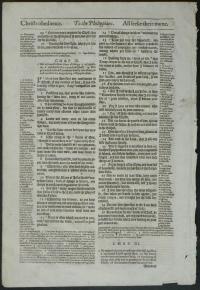
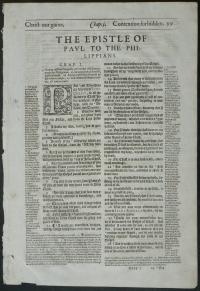 Leaf, 1616 Geneva Bible, Philippians ch 1 & 2, NT page 99-100. Printed by Robert Barker, London. 280 x 173, 8.5" x 12.5" ($15.00)
Leaf, 1616 Geneva Bible, Philippians ch 1 & 2, NT page 99-100. Printed by Robert Barker, London. 280 x 173, 8.5" x 12.5" ($15.00)Many of the commentaries written in the margin of the Geneva Bible expressed general Protestant beliefs, such as justification by faith alone. Some imparted Calvinist teachings on subjects such as predestination, some offered alternative translations, and some of the later editions even included strongly-worded condemnations of the Roman Catholic Church and British monarchy to which King James I strongly objected.
Printed in 12-point black letter, double columns, 64 lines per full column. Sidenotes in 7-pt Roman type; “argument” for each book in 10-pt Roman italics. [Herbert 348]
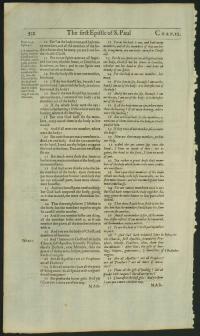
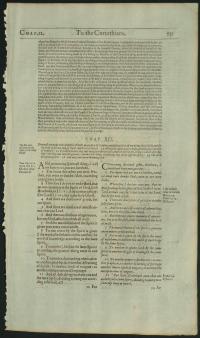 Leaf, 1617 Bishops and Catholic Rheims New Testament. 1 Corinthians 12:1-30, page 531-32. Printed by Thomas Adams, London. 274 x 170, 8.0" x 13.7" ($10.00)
Leaf, 1617 Bishops and Catholic Rheims New Testament. 1 Corinthians 12:1-30, page 531-32. Printed by Thomas Adams, London. 274 x 170, 8.0" x 13.7" ($10.00)This fascinating edition of the New Testament contains the texts of both the first Catholic English Rheims translation (1582) and the Protestant Bishop’s version (1568). Translation variations are evident in the side-by-side comparison. The intent of this edition was to be “A Confutation” of the Catholic work by the Protestant theologian William Fulke, D.D. Ironically, its publication secured for the Rheims translation a publicity which it would not have otherwise obtained in England. This work was first published in 1589 and reprinted in 1601, 1617 (this edition), 1633, and 250 years later in 1843.
Printed in Roman 10-pt, double columns, 62 lines per full column, Rheims in left column, Bishop’s in italics on right. Extensive commentary follows each chapter in single column 8-pt type, both regular and italics. [Herbert 359]
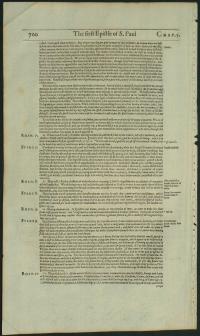
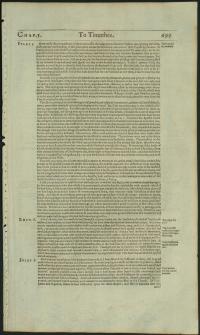 Leaf, 1617. Bishops and Catholic Rheims New Testament Commentary. Timothy ch 5, pages 699-700. Printed by Thomas Adams, London. 274 x 170, 8.0" x 13.7" ($10.00)
Leaf, 1617. Bishops and Catholic Rheims New Testament Commentary. Timothy ch 5, pages 699-700. Printed by Thomas Adams, London. 274 x 170, 8.0" x 13.7" ($10.00)Leaf contains the text of William Fulke’s “Confutation” of the Catholic translation, commenting on its supposed inaccuracies or political bias. William Fulke (1538-1589) was educated at Cambridge and active throughout his life as a Puritan controversialist. In 1580 he was appointed to defend Puritanism against the Roman Catholics, and in 1581 he was one of the disputants with the great English Jesuit, Edmund Campion. In later years he was selected by the privy council to argue against any Roman Catholic. He was author of a number of polemical writings such as the present example.
Leaf contains part of the extensive commentary on Timothy Ch 5. Single column 8-pt Roman type, both regular and italics. [Herbert 359]
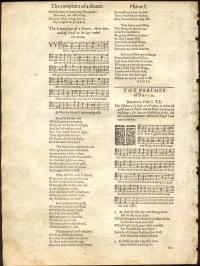
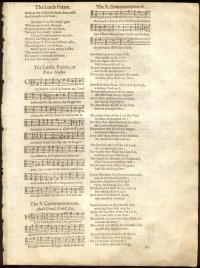 Leaf, 1617 Psalter, Lord’s Prayer, Ten Commandments, Psalm 1 with music stanzas. Printed by the Company of Stationers, London. 196 x 100, 6.2" x 8.3" ($22.00)
Leaf, 1617 Psalter, Lord’s Prayer, Ten Commandments, Psalm 1 with music stanzas. Printed by the Company of Stationers, London. 196 x 100, 6.2" x 8.3" ($22.00)The Psalms were written not merely as poems, but as songs for singing with more than a third of them addressed to the Director of Music. Much of the ancient music is lost, but from the 16th to 18th Centuries, new musical settings for the Psalms were commonly printed for singing in the back of Bibles or in stand-alone psalters.
Printed in small 7-pt Roman type, two narrow 1.8" wide columns, 70 lines per column with musical stanzas mixed in with the text.
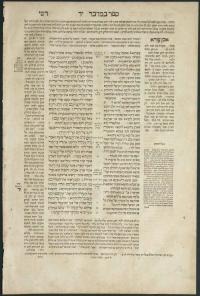
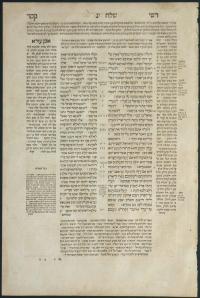 Leaf, 1618 Hebrew Bible: Sixth Biblia Rabbinica, with Targums and Commentaries, portion of the Pentateuch. Printed at Basel, Switzerland. 10.4" x 15.7" ($8.95)
Leaf, 1618 Hebrew Bible: Sixth Biblia Rabbinica, with Targums and Commentaries, portion of the Pentateuch. Printed at Basel, Switzerland. 10.4" x 15.7" ($8.95)This distinctively Jewish Rabbinic Bible in two volumes was revised and corrected by Johannes Buxtorf at the Univ of Basel, who devoted himself to developing an accurate Hebrew Bible with the classical rabbinic commentaries. This sixth Bible is his final version and takes into account Sephardi scholars and traditions as well.
In this classical folio-size presentation, the center of page has the text of Bible and Targumim facing one another in finely wrought square Hebrew letters provided with nikud (vowel points). The commentaries are in smaller type fonts in Rashi script surrounding the main body of the text. [Darlow & Moule 5120]
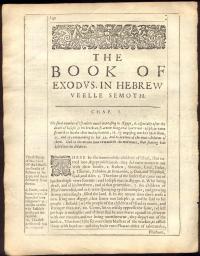
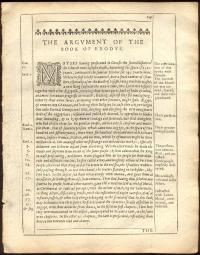 Leaf, 1635 Douay Catholic Bible. English. Exodus Argument and 1:1 - 1:11, pages 141-142. Printed by Jean Cousturier, Douay, France. 192 x 127, 6.9" x 8.9" ($26.00)
Leaf, 1635 Douay Catholic Bible. English. Exodus Argument and 1:1 - 1:11, pages 141-142. Printed by Jean Cousturier, Douay, France. 192 x 127, 6.9" x 8.9" ($26.00)The Douay–Rheims Bible is a translation of the Bible from the Latin Vulgate into English made by members of the English College, Douai, in the service of the Catholic Church. The New Testament portion was published in Reims, France, in 1582, in one volume with extensive commentary and notes. The Old Testament portion was published in two volumes thirty years later by the University of Douai. The first volume, covering Genesis through Job, was published in 1609; the second, covering Psalms to 2 Machabees plus the apocrypha of the Vulgate was published in 1610. Marginal notes took up the bulk of the volumes and had a strong polemical and patristic character. They offered insights on issues of translation, and on the Hebrew and Greek source texts of the Vulgate. The purpose of the version, both the text and notes, was to uphold Catholic tradition in the face of the Protestant Reformation which up until then had overwhelmingly dominated Elizabethan religion and academic debate. As such it was an impressive effort by English Catholics to support the Counter-Reformation. The last page contains an extract from the royal license granted to Iean le Cousturier of Rouen to print these Bibles in English, dated 3 August 1634.
Scripture text in 10-point Roman type, single column, 46 lines per column, with sidenotes and annotations in 8-point type. [Herbert 499]
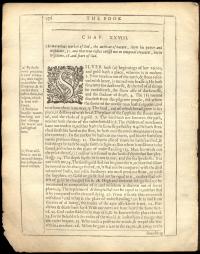
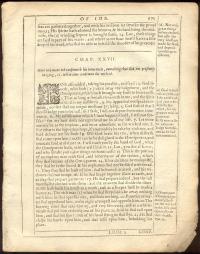 Leaf, 1635 Douay Catholic Bible. English. Job 26:13 - 28:25, pages 975-976. Printed by Jean Cousturier, Douay, France. 192 x 127, 6.9" x 8.9" ($26.00)
Leaf, 1635 Douay Catholic Bible. English. Job 26:13 - 28:25, pages 975-976. Printed by Jean Cousturier, Douay, France. 192 x 127, 6.9" x 8.9" ($26.00)This is a reprint of the second edition of the Catholic Old Testament in English first printed in Douay in 1609. At the Council of Trent in 1546, this translation was proclaimed the official Catholic version. Nevertheless, at a later session, the Council of Trent (1545-1564) placed the Bible on its list of prohibited books, and forbade any person to read the Bible without a license from a Roman Catholic bishop or inquisitor. The Council added these words: “That if any one shall dare to read or keep in his possession that book, without such a license, he shall not receive absolution till he has given it up to his ordinary.” This was reiterated in 1713 when Pope Clement XI in his bull, Unigenitus, wrote that “we strictly forbid them [the laity] to have the books of the Old and New Testament in the vulgar [common] tongue.” So it is clear that this Bible was printed for the church (priests and bishops) and not the laity. Indeed, for 115 years after this date (until 1750), not a single edition of the Douay-Rheims Catholic Bible was printed.
Published in two volumes, this quarto Bible is unusual in that each section of each page of a single column with sidenotes is separated or surrounded by rules. The text is continuous with no paragraph indents or breaks. Verse numbers are included in the text.
Scripture text 10-point Roman, single column, 46 lines per column, sidenotes and annotations in 8-pt type. [Herbert 499]
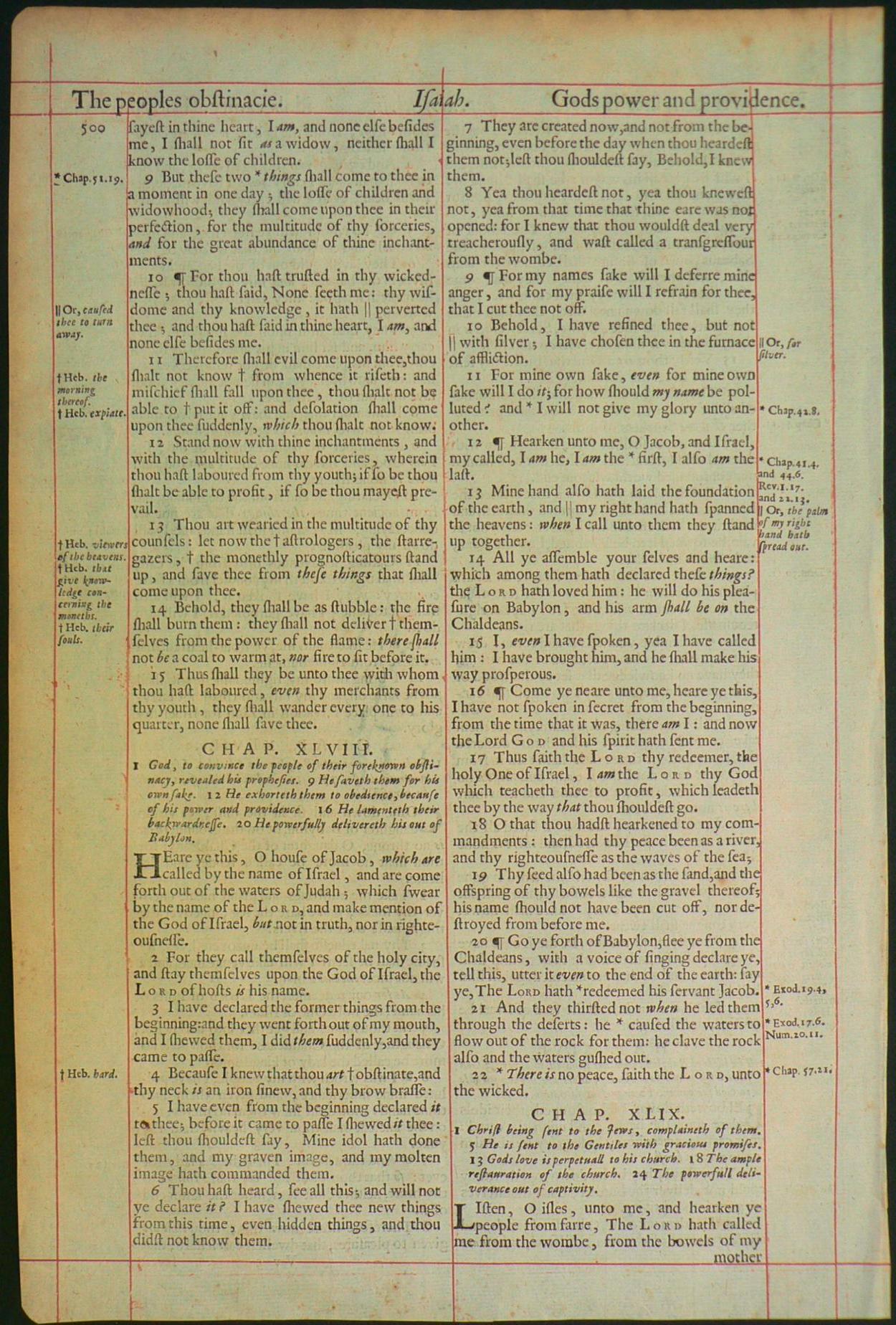
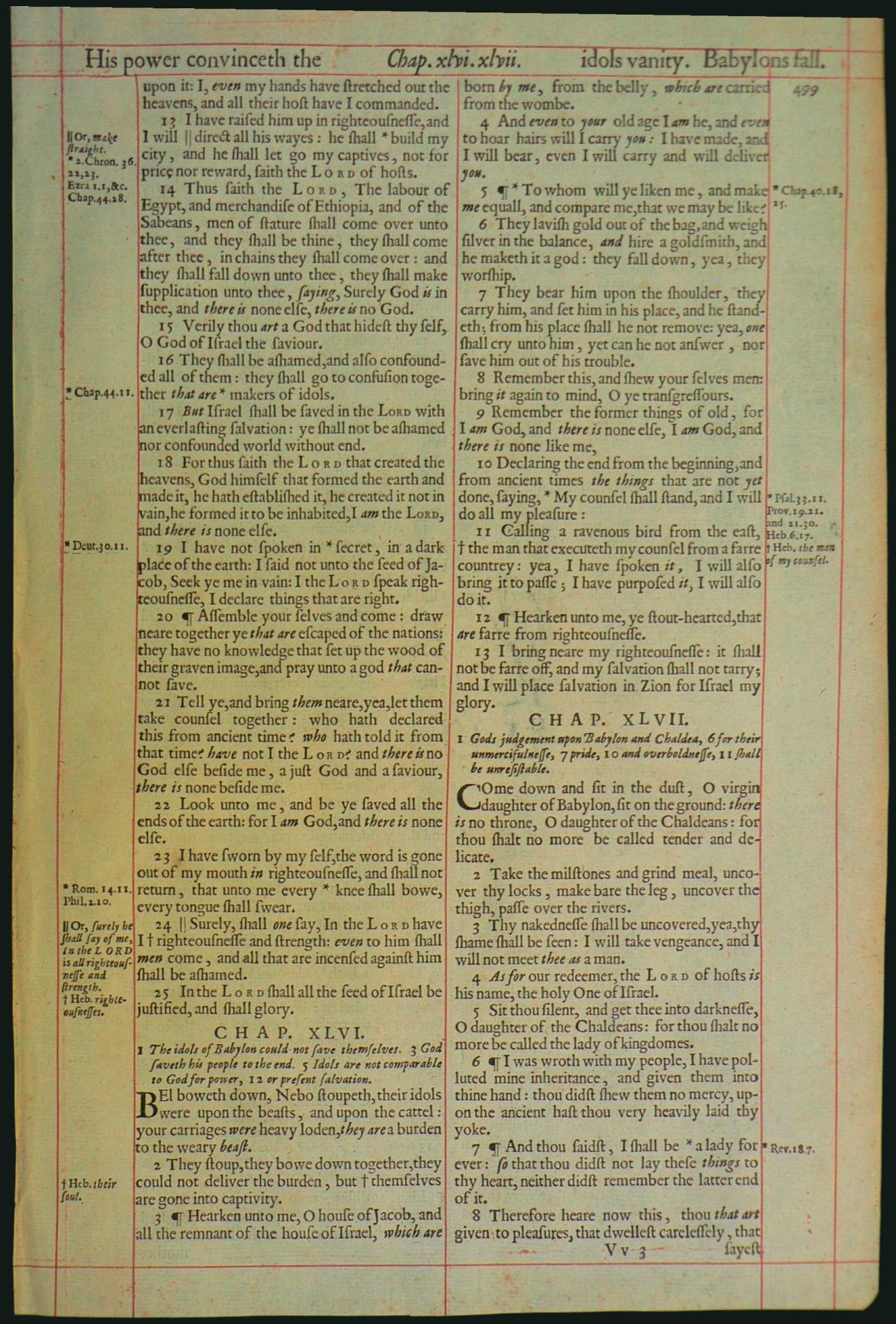 Leaf, 1638 KJV Cambridge Bible, Isaiah 45:13 - 49:1, pages 499-500. Printed by Thomas Buck & Roger Daniel, Univ of Cambridge, 9.5" x 14.7” ($16.00)
Leaf, 1638 KJV Cambridge Bible, Isaiah 45:13 - 49:1, pages 499-500. Printed by Thomas Buck & Roger Daniel, Univ of Cambridge, 9.5" x 14.7” ($16.00)In January 1604, King James I convened the Hampton Court Conference where a new English Bible version was conceived in response to the perceived problems of the earlier translations unduly influenced by the Puritans, a faction within the Church of England. The KJV is considered a towering achievement in English literature, both beautiful and scholarly.
First published in 1611, within 18 years it was already being corrected. The title page of this edition notes, “The authentique corrected Cambridge Bible, revised Mandato Regio by the learned Doctor Ward, Doctor Good &c.” In this edition, the work of correction begun in 1629 was carried further and a number of new readings were introduced that were later incorrectly ascribed to the Pilgrims. This edition is an important one and became the standard text used from 1638 until 1762.
Large folio-size leaf printed in 12-pt Roman type, double columns, 72 lines, with scripture references but minimal sidenotes. Red rules added by hand after printing for wealthy purchasers. [Herbert 520]
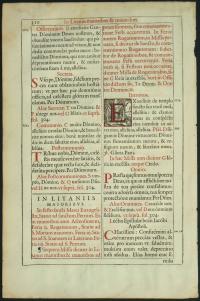
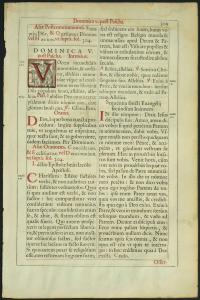 Leaf, 1642 Missale Romanum ex Decreto Sacrosancti Concilii Tridentini Restitutum. (The Roman Missal restored by the decree of the Council of Trent). Printed by Christophe Plantin, Antwerp. 9.0" x 13.5” ($4.95)
Leaf, 1642 Missale Romanum ex Decreto Sacrosancti Concilii Tridentini Restitutum. (The Roman Missal restored by the decree of the Council of Trent). Printed by Christophe Plantin, Antwerp. 9.0" x 13.5” ($4.95)Leaf is from a book of prayers for all the Holy Days of the year according to Catholic tradition and is handsomely executed in a style strikingly similar to the earliest printed Missals of the previous century.
This beautiful large-folio Missale is among the finest products of the press of Christophe Plantin, the outstanding scholar-printer of the age. Plantin, a Frenchman who settled in Antwerp, Belgium had a printing firm with 20 presses and 73 workmen, which was the premier printer of Bibles in the late 1500s. The printing dynasty he founded flourished well into the 17th century, and the original workshop today survives as the Plantin-Moretus Museum.
Printed in a large 16-point Roman typeface, double columns, text inside ruled borders. Leaf has seven printed Uncial initial letters in red ink with two large 5-line historiated (decorated) initial letters printed in red and black.
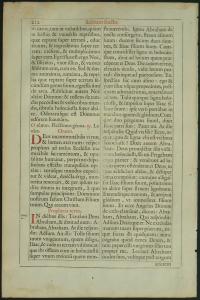
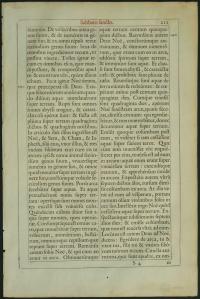 Leaf, 1642 Missale Romanum ex Decreto Sacrosancti Concilii Tridentini Restitutum. (The Roman Missal restored by the decree of the Council of Trent). Printed by Christophe Plantin, Antwerp. 9.0" x 13.5” ($2.95)
Leaf, 1642 Missale Romanum ex Decreto Sacrosancti Concilii Tridentini Restitutum. (The Roman Missal restored by the decree of the Council of Trent). Printed by Christophe Plantin, Antwerp. 9.0" x 13.5” ($2.95)Leaf is from a book of prayers for all the Holy Days of the year according to Catholic tradition and is executed in a style similar to the earliest printed Missals of the previous century. This page is mostly continued text so does not have the historiated initial letters for new subjects as the previous page does.
Printed in a large Roman typeface, double columns, text inside ruled borders. Page 212 has two printed Uncial initial letters in red ink.
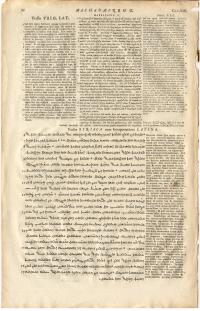
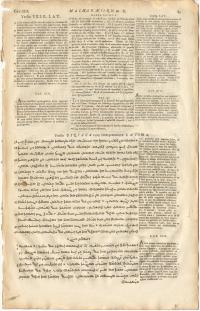 Leaf, 1657 London Polyglot Bible, Latin, Greek, Syriac. 2 Maccabees 12:38 - 13:17, page 87-88. Printed by Brian Walton, London. 394 x 241, 11.2" x 17.5" ($15.00) [Plus 2 following pages]
Leaf, 1657 London Polyglot Bible, Latin, Greek, Syriac. 2 Maccabees 12:38 - 13:17, page 87-88. Printed by Brian Walton, London. 394 x 241, 11.2" x 17.5" ($15.00) [Plus 2 following pages]Leaf is from one of six great folios of Brian Walton’s Polyglot Bible. The great undertaking was supported by liberal subscriptions and some help from the Commonwealth. Walton was aided by at least eight collaborators, but however much he was indebted to them, the Polyglot Bible is a great monument to Walton’s industry and capacity for directing a vast undertaking. Walton was made bishop of Chester in December 1660, three years after the appearance of the Polyglot, but died less than a year later.
Printed in the upper right of the leaves in this folio is the Vulgate in Latin. The center column contains the same verses from the “original” Greek and next to that is a translation of the Greek into Latin. Taking most of the bottom of the page are the same verses in Syraic Aramaic and its translation into Latin. Thus, scholars can compare the three Latin translations for differences that perhaps should be resolved or at least recognized.
Folio size page. The Vulgate and Syraic Latin translations are printed in a 9-point Roman typeface, the Latin of the Greek translation is in an 8-point italic Roman, and the Greek and Syraic are, of course, in their own unique typefaces.

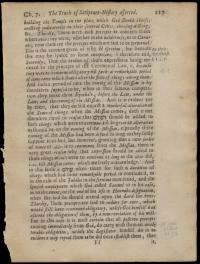 Leaf, 1662 book by Edward Stillingfleet, “Origines Sacrae, Or, A Rational Account of the Grounds of Christian Faith, as to the Truth and Divine Authority of the Scriptures, and Matters Therein Contained,” page 217-18, 5.5" x 7.3" ($1.00)
Leaf, 1662 book by Edward Stillingfleet, “Origines Sacrae, Or, A Rational Account of the Grounds of Christian Faith, as to the Truth and Divine Authority of the Scriptures, and Matters Therein Contained,” page 217-18, 5.5" x 7.3" ($1.00)Edward Stillingfleet (1635 –1699) was a British theologian, scholar, and outstanding preacher as well as a strong polemical writer defending Anglicanism. In asserting the divine authority of the scriptures, Origines Sacrae began with a comprehensive analysis of flaws of ancient historians, as a way of defending the account in the Book of Genesis. As a result of the brilliance of his writings he received rapid promotion serving as the Canon of Canterbury, Archdeacon of London, and at the relatively young age of 54 he became Bishop of Worcester.
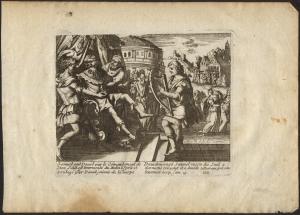 Illustration, 1670 La Sainte Bible, French. 1 Samuel 19:10. Published by Gérard Jollain, Paris, 10.0" x 7.1" ($16.20)
Illustration, 1670 La Sainte Bible, French. 1 Samuel 19:10. Published by Gérard Jollain, Paris, 10.0" x 7.1" ($16.20)This illustration is described as being published in “The Holy Bible, Containing the Old and New Testament, Enriched with several beautiful figures.” The Bible contained 269 full-page illustrations, each with a caption below it in French and Latin. This copper engraving depicts 1 Samuel 19:10 – "Then an evil spirit from the LORD came upon Saul. He was sitting in his house with his spear in his hand, while David was playing the harp." The engraver was probably a member of the Jollain family.
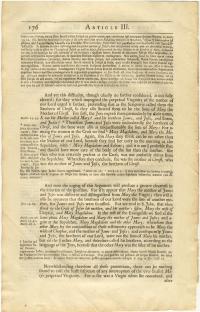
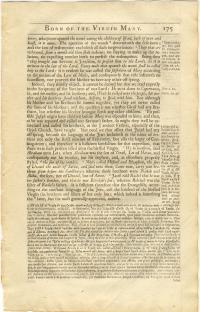 Leaf, 1683 Book of Sermons, English. 264 x 154, 7.8" x 12.4" ($3.00)
Leaf, 1683 Book of Sermons, English. 264 x 154, 7.8" x 12.4" ($3.00)Sermon text contains a portion of a discussion and defense of the Apostles Creed, specifically “Born of the Virgin Mary.” This page with three languages is from “An Exposition of the Creed," 5th Edition Revised and Enlarged by John Pearson, Lord Bishop of Chester. Published by J.M.(?) for John Williams at The Crown in St Paul's Church-yard, London 1683.
Main text is 10-point Roman, notes on top, bottom, and side of page are in English (8-pt Roman italics), Latin (8-pt Roman), and Greek (8 pt).
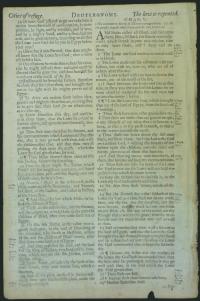
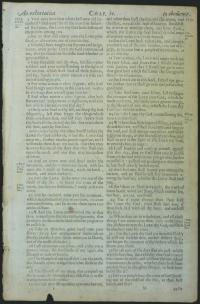 Leaf, 1684 KJV Bible, Deuteronmy 4:3 - 5:19. The Theater, Oxford, Sold by Thomas Guy, Oxford Arms. 304 x 190, 8.5" x 12.7" ($6.00)
Leaf, 1684 KJV Bible, Deuteronmy 4:3 - 5:19. The Theater, Oxford, Sold by Thomas Guy, Oxford Arms. 304 x 190, 8.5" x 12.7" ($6.00)In January 1604, King James I convened the Hampton Court Conference where a new English Bible version was conceived in response to the perceived problems of the earlier translations unduly influenced by the Puritans, a faction within the Church of England. Instructions to the translators were intended to guarantee that the new version would conform to the theology of Christianity and reflect the episcopal structure of the Church of England and its belief in an ordained clergy. The translation was done by 47 premier scholars. In common with most other translations of the period, the New Testament was translated from Greek, the Old Testament was translated from Hebrew and Aramaic text, while the Apocrypha was translated from the Greek and Latin.
This 1684 Bible is almost an exact reprint of the first English Bible printed at Oxford in 1675, which was a “corrected” version of the original 1611 edition.
Folio-size page with large 12-pt Roman type, double columns, 64 lines, virtually no sidenotes, a few scripture references. [Herbert 790]
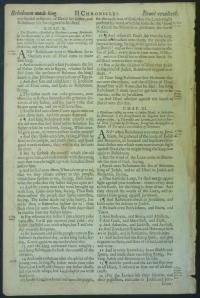
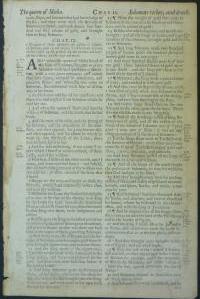 Leaf, 1684 KJV Bible, 2 Chronicles 8:18 - 11:14. The Theater, Oxford, Sold by Thomas Guy, Oxford Arms. 304 x 190, 8.5" x 12.7" ($6.00)
Leaf, 1684 KJV Bible, 2 Chronicles 8:18 - 11:14. The Theater, Oxford, Sold by Thomas Guy, Oxford Arms. 304 x 190, 8.5" x 12.7" ($6.00)In some ways it is ironic that King James I, scandalously bisexual, profligate with money, a passionate believer in the divine rights of kings, and described as “God’s silly vassal,” should have commissioned this towering achievement in English literature. By the first half of the 18th century, the KJV had become effectively unchallenged as the English translation used in virtually all Anglican and Protestant churches in England. Both beautiful and scholarly, the KJV became the most printed book in history.
Editing, corrections and revisions started almost immediately, but this 1684 Bible is a fairly close reprint of the first English Bible printed at Oxford in 1675, which was a “corrected” version of the original 1611 edition.
Folio-size page with large 12-pt Roman type, double columns, 64 lines, virtually no sidenotes, a few scripture references. [Herbert 790]
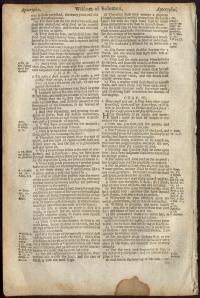
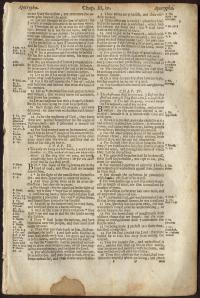 Leaf, 1692 KJV Bible, Wisdom of Solomon 2:11 - 6:18. Printed by Heir of A. Anderson, Edinburgh. 162 x 103, 4.8" x 7.2" ($2.00)
Leaf, 1692 KJV Bible, Wisdom of Solomon 2:11 - 6:18. Printed by Heir of A. Anderson, Edinburgh. 162 x 103, 4.8" x 7.2" ($2.00)The KJV was meant to replace the Bishops’ Bible as the official version for readings in the Church of England. No record of its authorization exists; it was probably effected by an order of the Privy Council. Nevertheless, it is commonly known as the "Authorized Version" in the United Kingdom.
Octavo size, tiny 6-point Roman type, double columns, 77 lines, the usual minimal sidenotes in 5-pt type. [Herbert 825. Could possibly be No. 727, printed 1676 by Bill & Barker, London.]
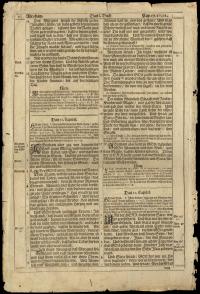
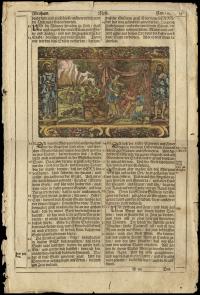 Leaf with Engraving, 1693 Biblia: Die Heilige Schrifft dess Alten und Neuen Testaments. [Bible: The Holy Scriptures of the Old and New Testaments] by Martin Luther, German, Genesis 19:12-21:6. Printed by Johann Andrea Endters, Nurnberg. 328 x 209, 9.3" x 13.8" ($21.90)
Leaf with Engraving, 1693 Biblia: Die Heilige Schrifft dess Alten und Neuen Testaments. [Bible: The Holy Scriptures of the Old and New Testaments] by Martin Luther, German, Genesis 19:12-21:6. Printed by Johann Andrea Endters, Nurnberg. 328 x 209, 9.3" x 13.8" ($21.90)The theologian, Johannes Michael Dilherr (1604 - 1669), wrote the preface for this Bible, so it is often called “the Dilherr Bible.” Dilherr was a professor at Jena, and served as a preacher at St. Sebald in Nurnberg. The Dilherr Bible provided great success for the Endters printing firm as from 1656 to 1788 at least 32 editions were published. Each has raw text of the Luther Bible, but for family reading interspersed in the text-columns are woodcuts that simultaneously make the Bible almost a storybook.
Folio size, printed in large 16-point gothic black letter, double columns, 65 lines, with verse numbers to left of column and narrow column of minimal sidenotes. Chapter introductions, footnotes, and sidenotes in 11-pt black letter. Approx 3/8 of one side is a fine hand colored woodcut engraving of Destruction of Sodom and Gomorrah, with mannerist border.
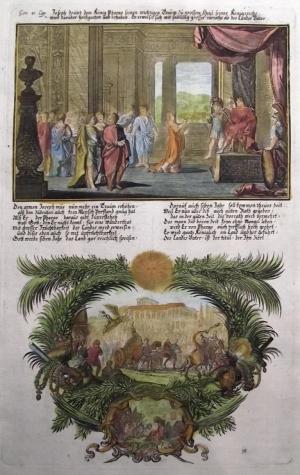 Engraving, 1694 Biblische Engel und Kunstwerk [Biblical Angels and Artwork], German, Genesis 41:17-32 (Joseph interprets Pharaoh’s dreams). Published by Melchior Küsel, Augsburg, Germany. 13.7" x 8.5" ($22.95)
Engraving, 1694 Biblische Engel und Kunstwerk [Biblical Angels and Artwork], German, Genesis 41:17-32 (Joseph interprets Pharaoh’s dreams). Published by Melchior Küsel, Augsburg, Germany. 13.7" x 8.5" ($22.95)Superb folio engraving from Kraus’ masterpiece of baroque bible illustration, Biblische Engel und Kunstwerk. Johann Ulrich Kraus (also Krauss, Krauß, 1655–1719) was an early German illustrator, engraver and publisher in Augsburg. He was a student of Melchior Küsel (1626- ca.1683), who was in turn a student of Matthäus Merian the Elder. Kraus became a partner in the Augsburg publishing company of Melchior Küsel, whose daughter Johanna Sibylla he married in 1685. He was one of the most successful and respected illustrators of his generation in Augsburg.
In 1687 Kraus published his first work: a reproduction of the Tapisseries du roy, which had first been published in Paris in 1679. They were etched by his wife Johanna, who had also been trained by her father. Biblische Engel und Kunstwerk followed in 1694 and led the way for a whole series of religious books for which Kraus had developed a relatively uniform print layout, thus ensuring that his publications formed a visually recognizable brand. In the uppermost portion of each engraving is a large Biblical scene in rectangular format, with caption; the lower half of the plate is occupied by a smaller related vignette scene (or occasionally several scenes) within variously shaped cartouches, framed in a plethora of different elaborate emblematic and ornamental borders. It is this latter “free-style” component of each of the Krauss plates, characterized by a fantastic variety of ornamental invention, that a reviewer praised as their “most artistically interesting element,” exhibiting a “great richness of ideas.”
Kraus’ business was damaged in the War of the Spanish Succession, but he seems to have recovered and in 1717 is recorded in the archives of Augsburg as a wealthy citizen.
Folio size page, copper engraving, colored by hand, with scripture in a decorative italic font in two columns. A later more common and less well engraved quarto edition was also issued. Most surviving Kraus prints are not colored.
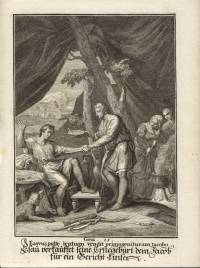 Engraving, 1695 Biblia Ectypa, German, Latin. Genesis 25:33-34 (Esau sells his birthright to Jacob for a bowl of lentil stew). Published by Christoph Weigel, Augsburg, Germany. 267 x 175 mm, 8.75" x 13.8" ($14.00)
Engraving, 1695 Biblia Ectypa, German, Latin. Genesis 25:33-34 (Esau sells his birthright to Jacob for a bowl of lentil stew). Published by Christoph Weigel, Augsburg, Germany. 267 x 175 mm, 8.75" x 13.8" ($14.00)This detailed copper engraving by Christoph Weigel shows Esau holding his hand up as a pledge of the sale of his birthright to Jacob for a bowl of lentil stew. Rebekah, the boys’ mother and another woman, along with two dogs look on.
The Biblia Ectypa is fully engraved pictorial Bible. Instead of being an illustrated Bible (i.e. text embellished by illustrations), the Biblia Ectypa tells the whole Bible story entirely in beautifully-executed copper engravings. More than 830 highly detailed engravings are employed to tell hundreds of Biblical tales, with authentic costumes, architecture and social customs all skillfully captured. Each illustration is also accompanied by a short caption in Latin and an engraved quotation from the German Bible.
The Biblia Ectypa was a critical and commercial success for Weigel, who enjoyed a long career in Augsburg and Nuremburg as a map and print engraver and illustrator, and as publisher of at least seventy books.
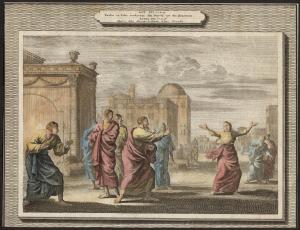 Illustration, 1700 L'Histoire du vieux et du Nouveau Testament [History of Old and New Testament], French and Dutch. Acts 16:16-18. Published by Pieter Mortier, Amsterdam. 9.0" x 6.8" ($22.33)
Illustration, 1700 L'Histoire du vieux et du Nouveau Testament [History of Old and New Testament], French and Dutch. Acts 16:16-18. Published by Pieter Mortier, Amsterdam. 9.0" x 6.8" ($22.33)In this sumptuously illustrated print Bible, commonly known as Mortier’s Large Bible, the obsessive tendency of Golden Age Dutch culture to illustrate overwhelms any Calvinist scruple over the sinfulness or inadequacy of pictures in relation to the actual scripture. The Bible contains 214 engraved plates, each with two illustrations of biblical scenes with engraved text in Dutch and French, drawn by one of two artists. The Bible foreword and text for each plate were written by the French Protestant theologian David Martin and the Dutch translated by Willem Sewel.
In this half-page horizontal hand-colored copper engraving, Paul commands a demon to leave a slave girl. This unsigned illustration is by either of two much admired contemporary Dutch engravers, Jan Luyken or Bernard Picart III de Hooghe.
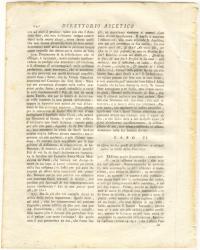
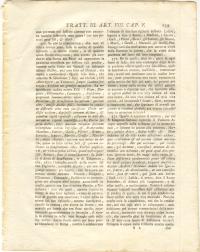 Leaf, c 1700s Ascetic Directive, Italian. Directives 371-376, Page 139-140. Printed Venice, Italy. 208 x 142, 7.9" x 10.1" ($3.00)
Leaf, c 1700s Ascetic Directive, Italian. Directives 371-376, Page 139-140. Printed Venice, Italy. 208 x 142, 7.9" x 10.1" ($3.00)Page is apparently a Roman Catholic church directive to priests. It discusses items like three degrees of perfection, those devoid of faith, the tribulation, finding peace, and avoiding impatience. This is most likely part of a larger book of church directives to priests.
Two columns of 9-point Roman type with Latin references and chapter introductions in italics.
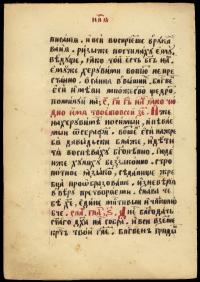
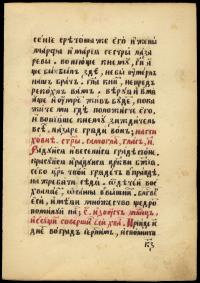 Leaf (2), c. 1700s Russian Orthodox Bible, Old Church Slavonic. 196 x 120, 7.0" x 10.0" ($12.00 each)
Leaf (2), c. 1700s Russian Orthodox Bible, Old Church Slavonic. 196 x 120, 7.0" x 10.0" ($12.00 each)These two manuscript leaves are beautifully handwritten in the Cyrillic alphabet of the Old Church Slavonic language. The calligraphic writing is in black with red rubrication of individual letters, words, and entire sentences. Margins and some lines are ruled very lightly in pencil.
(Click here to see the second two pages.)
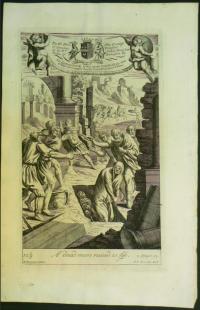
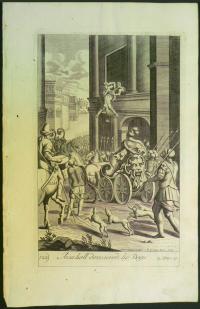 Illustrations, 1701 The History of the Old and New Testament, by Nicholas Fontaine (pseudonym, Sieur De Royaumont), English. 2 Kings 9:33 and 13:21, plates 122, 123. Engravings by G. Freman. Printed for Blome, Sprint, Nicolson and Pero, London. 10.8" x 16.5" ($11.00)
Illustrations, 1701 The History of the Old and New Testament, by Nicholas Fontaine (pseudonym, Sieur De Royaumont), English. 2 Kings 9:33 and 13:21, plates 122, 123. Engravings by G. Freman. Printed for Blome, Sprint, Nicolson and Pero, London. 10.8" x 16.5" ($11.00)This historical account was “extracted out of the sacred Scriptures and writings of the Fathers to which are added the lives, travels and sufferings of the apostles with a large and exact historical chronology of all the affairs and actions related in the Bible. Illustrated with 234 engravings and three maps. The work has to be considered one of the most important works of the Protestant Reformation in France, amounting to a virtual translation of the Biblical text, integrated with commentary and breathtaking illustrations.”
Many of these illustrations were financed by wealthy patrons that were noted at the top of the plate. Engraving #123 was financed by Ann, Countess of Coventry, daughter of Henry, late Duke of Beaufort.
Copper Plate Bible Engraving #122 depicts two eunuchs about to drop Queen Jezebel (Ahab’s wife) from the palace window on Jehu’s orders (2 Kings 9:32-37). Engraving #123 depicts a dead man coming alive after touching Elisha’s dead bones (2 Kings 13:21).
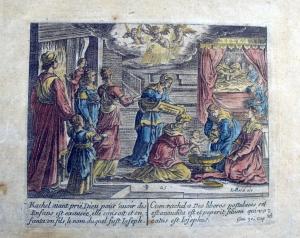 Illustration, 1703 La Sainte Bible, French. Genesis 30:23-24. Published by Gérard Jollain, Paris, 10.2" x 7.1" ($14.60)
Illustration, 1703 La Sainte Bible, French. Genesis 30:23-24. Published by Gérard Jollain, Paris, 10.2" x 7.1" ($14.60)Beautifully illustrated horizontal format Bible (The Bible Saincte containing the Old and New Testament enriched with many beautiful figures) with 267 engraved plates (147 OT and 120 NT). Below each illustration is a caption in French and Latin. This hand colored copper engraving depicts Rachel and Jacob’s family from Genesis 30.
Jollain (or Jolin) was the name of a family of French engravers and engraving publishers who lived and worked in the 17th and 18th centuries, mainly in Paris. Gérard Jollain (Born ?, died 28 May 1683) was a copper engraver. Bénézit notes that he resided on the Rue Saint-Jacques in Paris under the shop sign Ville de Cologne and was the father of François-Gérard Jollain.
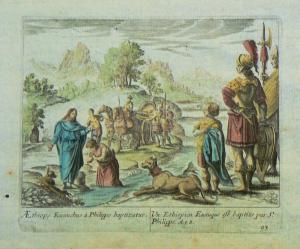 Illustration, 1703 La Sainte Bible, French. Acts 8:36-38. Published by Gérard Jollain, Paris, 10.2" x 7.1" ($14.60)
Illustration, 1703 La Sainte Bible, French. Acts 8:36-38. Published by Gérard Jollain, Paris, 10.2" x 7.1" ($14.60)Beautifully illustrated horizontal format Bible (The Bible Saincte containing the Old and New Testament enriched with many beautiful figures) with 267 engraved plates (147 OT and 120 NT). Below each illustration is a caption in French and Latin. Hand colored copper engraving shows Philip baptizing the Ethiopian Eunuch from Acts 8:36-38.
The seller attributes this leaf to the book, “The life and miracles of Christ from the New Testament,” by Gerard Jollain, printed in Paris 1650, reprinted c.1780, which is possible but seems unlikely.
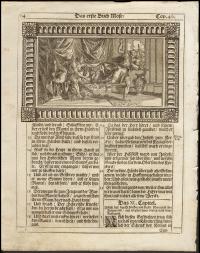
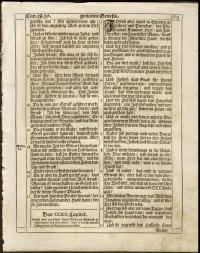 Leaf, 1705 Ulenberg Bible, German, Genesis Ch 38:23 - 40:1, with engraving of Joseph fleeing from Potiphar’s wife (Gen 39:13). Printed in Bamberg, Germany, 8.7" x 10.9" ($15.00)
Leaf, 1705 Ulenberg Bible, German, Genesis Ch 38:23 - 40:1, with engraving of Joseph fleeing from Potiphar’s wife (Gen 39:13). Printed in Bamberg, Germany, 8.7" x 10.9" ($15.00)The Dietenberger Bible published in 1534 in Mainz was the first full Catholic Bible with Old and New Testaments in German and was published the same year Martin Luther finished his Bible. In 1614, the Cologne Archbishop Ferdinand of Bavaria assigned noted theologian Kaspar Ulenberg to edit and correct the Dietenberger translation, which he completed shortly before his death in 1617. The first Ulenberg edition was not printed until 1630 in Cologne; eleven other editions were published in Cologne through 1747, and eleven more at Nuremberg, Bamberg, Frankfort, and Vienna. This version, printed in 1705, is one of two editions printed in Bamberg in the 18th century. The linguistic changes in the various editions of the Dietenberger-Ulenberg Bible remained relevant until the late 18th Century; until then it was the most common Bible translation in all German Catholic regions.
Printed in an ornate Gothic Fraktur typeface, double columns, 50 lines. Has a 3.0" x 5.4" woodcut of Joseph refusing the wife of Potiphar the Egyptian. [Ref for original 1534 page: Darlow & Moule 4200]
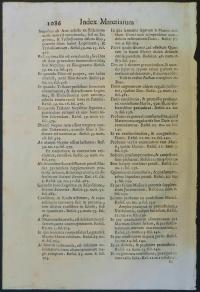
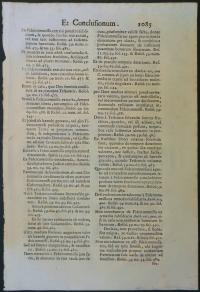 Leaf, 1709 Church decree, Latin, “Index of Materials and Conclusions,” page 1085-86. 275 x 168, 8.7" x 12.9" ($1.00)
Leaf, 1709 Church decree, Latin, “Index of Materials and Conclusions,” page 1085-86. 275 x 168, 8.7" x 12.9" ($1.00)The Roman Catholic Church bishops and Pope issue many official documents, most more or less descriptive of their character. They include “constitutions, encyclicals, decrees, decretals rescripts, and privileges.” A decree, such as this one, is a pronouncement on points affecting the general welfare of the Church. It is the only document that does not have anything to do with theology, but just the business and management of the physical church.
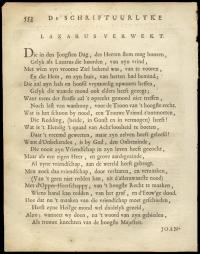
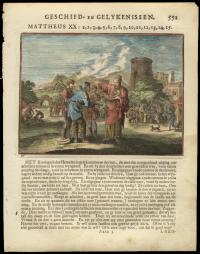 Engraving, 1712 Schriftuurlyke Geschiedenissen en Gelykenissen, van het Oude en Nieuwe Verbond, [Scripture: Histories, Parables of the Old & New Testaments] by Joannes Luiken, Dutch, Matthew 20:1-15. Published by the Widow of Pieter Arentz and Kornelis van der Sys, Amsterdam, 6.7" x 9.1" ($11.47)
Engraving, 1712 Schriftuurlyke Geschiedenissen en Gelykenissen, van het Oude en Nieuwe Verbond, [Scripture: Histories, Parables of the Old & New Testaments] by Joannes Luiken, Dutch, Matthew 20:1-15. Published by the Widow of Pieter Arentz and Kornelis van der Sys, Amsterdam, 6.7" x 9.1" ($11.47)Superb hand colored copper engraving of the parable of the workers paid equally (Illustration #88 of 148) by Joannes Luiken (or Jan Luyken, April 16, 1649 - April 5, 1712) who was a Dutch poet, illustrator and engraver. He was the son of Mennonite parents but was a high-spirited young man with an eye for beautiful women. In 1672, he married the singer Maria de Ouden and had five children all of whom died young with the exception of his son Caspar, who later also became an engraver. When Joannes was 26 years old, he had an unusual religious experience or vision that 1) he would live a robust life and 2) he was a Baptist. These festive and religious feelings were later reflected in his poetry.
From 1677 he began to concentrate on etchings and engravings, and he made his name as ingenious etcher in 1680 with 24 illustrations from a popular history book about the Dutch wars. Luiken is also known for a folio of moralistic prints as well as many etchings about the suffering of Christian Martyrs called Religious Persecutions. Joris-Karl Huysmans’ fictional anti-hero Jean Des Esseintes, a reclusive decadent Parisian, described them as “appalling engravings containing all the tortures that the madness of religion could devise.”
Book contains illustrations by both Joannes and Caspar Luiken, engraved by Pieter Sluyter. Quarto size page with hand colored copper engraving (5.9" x 4.3"), scripture below in Roman type in a single column. Most of the surviving prints from this book are not colored. The reverse of the leaf contains the story of Lazarus in prose from John Chapter 11.
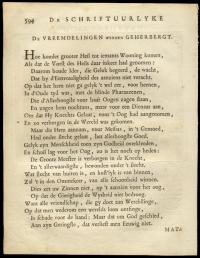
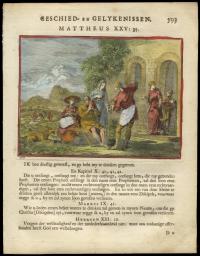 Engraving, 1712 Schriftuurlyke Geschiedenissen en Gelykenissen, van het Oude en Nieuwe Verbond, [Scripture: Histories, Parables of the Old & New Testaments] by Joannes Luiken, Dutch, Matthew 25:35. Published by the Widow of Pieter Arentz and Kornelis van der Sys, Amsterdam, 6.7" x 9.1" ($11.47)
Engraving, 1712 Schriftuurlyke Geschiedenissen en Gelykenissen, van het Oude en Nieuwe Verbond, [Scripture: Histories, Parables of the Old & New Testaments] by Joannes Luiken, Dutch, Matthew 25:35. Published by the Widow of Pieter Arentz and Kornelis van der Sys, Amsterdam, 6.7" x 9.1" ($11.47)Superb hand colored copper engraving illustrating the idea of giving a needy person something to eat or drink. Has scripture from Matthew 25:35, Matthew 10:40-42, Mark 9:41, and Hebrews 13:16. Illustration #107 of 148.
Book contains illustrations by both Joannes and Caspar Luiken, engraved by Pieter Sluyter. Quarto size page with hand colored copper engraving (5.9" x 4.3"), scripture below in Roman type in a single column. Most of the surviving prints from this book are not colored.
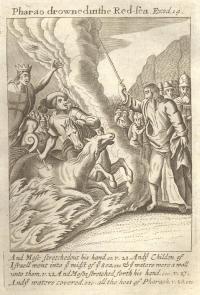 Illustration, 1716 KJV Old Testament, Exodus 14:22, 27. 7.8" x 9.8" ($11.00)
Illustration, 1716 KJV Old Testament, Exodus 14:22, 27. 7.8" x 9.8" ($11.00)Copper plate engraving depicts Moses parting of the Red Sea; it has quotes from Exodus 14:22 and 14:27. But where is it originally from? We don’t know.
One intriguing possibility is a KJV Bible printed by John Baskett, Oxford in 1716. It contained more than 60 neo-classical engravings by eminent artists like James Thornhill, Michael van der Gucht, and Claude Du Bosc. Along with the NT volume printed in 1717, it could have been one of the highlights of Baskett’s career. Instead so many printing mistakes were made that people referred to his Bible as a Baskett-ful of errors. One of the most famous misprints occurred in the page heading in Luke 20:9, where The Parable of the Vineyard became The Parable of the Vinegar, hence the nickname of “Vinegar Bible.” (Herbert 939)
Before 1750 the illustrations in most English Bibles came from separately published suites of designs by independent engravers and were added to the plain texts of the Bible by the bookseller or purchaser. This engraving could have been from such a portfolio.
The seller (Doyle Flowers of HIS Books) says this page is a reprint of an earlier one from late 1600s in which case, it might have come from one of the many KJV Bibles printed by “the assigns of Bill and Barker, London”or “The Theater, Oxford.”
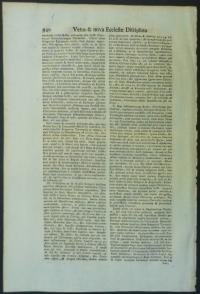
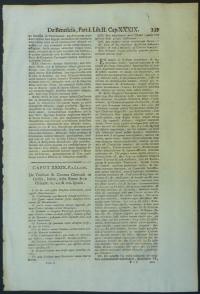 Leaf, 1729 De Beneficiis, Vetus & nova Ecclesiae Disciplina (Church doctrine: The Benefits of Old and New Church Discipline), Part I, Book 2,Chapter 39, “The shaven clerical crown in France, Italy, the city of Rome & the Orient.” Latin. 272x 152, 9.0" x 13.0" ($1.00)
Leaf, 1729 De Beneficiis, Vetus & nova Ecclesiae Disciplina (Church doctrine: The Benefits of Old and New Church Discipline), Part I, Book 2,Chapter 39, “The shaven clerical crown in France, Italy, the city of Rome & the Orient.” Latin. 272x 152, 9.0" x 13.0" ($1.00)Tonsure is the practice of cutting or shaving some or all of the hair on the scalp, as a sign of religious devotion or humility. Tradition states that it originated with the disciples of Jesus, who are said to have observed the Torah command not to shave the hair around the sides of one's head. In the Latin or Western Rite of the Catholic Church, “first tonsure” was, in medieval times and generally through 1972, the rite of inducting someone into the clergy and qualifying him for the civil benefits enjoyed by clerics. Tonsure was abandoned by papal order in 1972. This 1729 leaf discusses the differences in tonsure in various parts of the world.
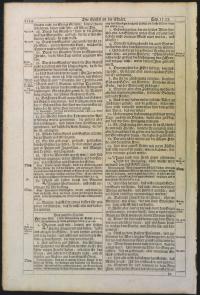
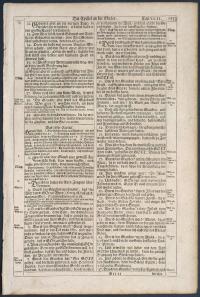 Leaf, 1736 Biblia, Das ist: Die gantze Heilige Schrif (Bible: The Complete Holy Scripture), German. Hebrews 10:32 - 12:22. Printed by Johann Andreas Endters, Nuremberg. 10.0" x 15.0" ($4.00)
Leaf, 1736 Biblia, Das ist: Die gantze Heilige Schrif (Bible: The Complete Holy Scripture), German. Hebrews 10:32 - 12:22. Printed by Johann Andreas Endters, Nuremberg. 10.0" x 15.0" ($4.00)German vernacular Bible contains the Lutheran version of the scriptures, which first appeared in 1522, and was published “with the approval” of the King of the German city-state. With the summaries by Johann Sauberti Seel, also with the diverse and educational benefits, on all chapters by the Lord D. Salomon Klassen Seel. In the text were injected countless pages of biographies of the Prophet, called electors.
Folio-size printed in large 16-pt black letter, double columns, 70 lines per column. Notes are interspersed in the text and scripture references are on the sides.
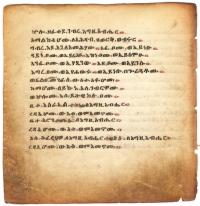
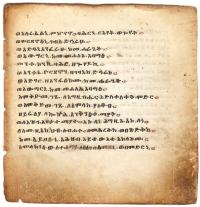 Leaf, Ethiopian Bible, undated (c. 1700s?). Hand written in Amharic in Ge'ez script on vellum. 5.7" x 5.8" ($14.00)
Leaf, Ethiopian Bible, undated (c. 1700s?). Hand written in Amharic in Ge'ez script on vellum. 5.7" x 5.8" ($14.00)Ge’ez language is one of the Semitic languages spoken in Ethiopia in the past; and probably originated from two sources: The Sabaean language originated in Southern Yemen few centuries B.C; and represents an old Arabic Semitic language spoken by the famous biblical Queen of Sheba. It was also known as Himyarite language. The second source was from Egypt during the Hyksos ruling. The Hyksos were Semitic tribes that invaded old Egypt and ruled for 400 years. When they were expelled out of Egypt they fled to Nuba, Ethiopia, and Canaan. The Christian Kingdom of Aksum (old Ethiopia) had occupied Yemen in the early centuries A.D. The Ge’ez language is a combination of the two; the Semitic and the old Ethiopian languages. It vanished with time and nowadays is only used in biblical and Christian Orthodox schools in old Ethiopia.
Leaf is from an old Coptic Bible or Psalms book leaf on vellum, calf or goat skin with bold black and red ink. The red ink is usually used for the name of God or saints (or the end of sentences). The seller could not identify the date or content; but based on a similar page in the Turpin Library, it appears to be copied in an 18th century hand.
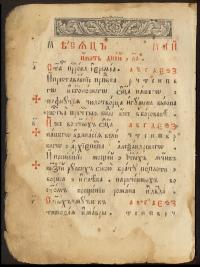
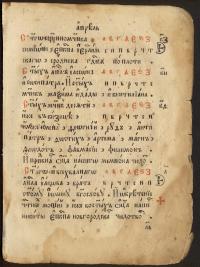 Leaf, c. 1740-90 Slavonic Psalter, 163 x 116, 6.3" x 8.1" ($16.00)
Leaf, c. 1740-90 Slavonic Psalter, 163 x 116, 6.3" x 8.1" ($16.00)Unfortunately, the book from which this leaf came is missing some pages including the one containing the date and publisher name. A scholar in Slavonic languages opines it was probably printed in the 1740-1790 range according to the engraver of the woodcuts Hieromonk Sebastian. The language is Old Church Slavonic (Russian recension of Old Slavonic).
Octavo size page, one column, 17 lines of large 18-pt type. Typography and printing probably by Ukraine’s Kiev Pechersk Lavra (Kiev Monastery of the Caves), a historic Orthodox Christian monastery.
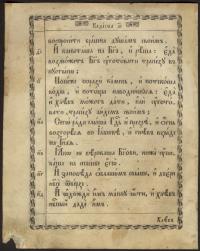
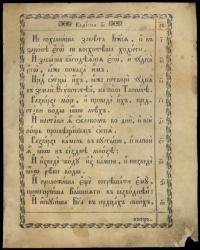 Leaf, c. 1740-90 Slavonic Psalter, 184 x 130, 6.5" x 8.3" ($11.50)
Leaf, c. 1740-90 Slavonic Psalter, 184 x 130, 6.5" x 8.3" ($11.50)This leaf is similar but has slight differences from the one above. It has a simple decorative border, there is a side column containing two-character notations, and it is printed only in black.
Typeface and printing dimensions are similar enough to say that this page probably also came from Ukraine’s Kiev Pechersk Lavra Monastery.
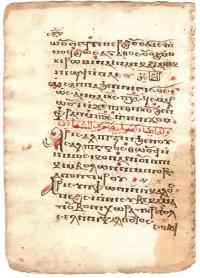
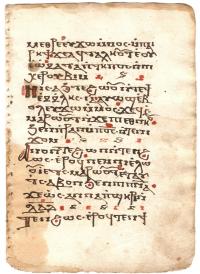 Leaf, c. 1750 Psalis and Doxologies manuscript for the Coptic Year. Egypt. Text handwritten in Coptic. Undated but probably 250+ years old. 6.5" x 9.1" ($20.00)
Leaf, c. 1750 Psalis and Doxologies manuscript for the Coptic Year. Egypt. Text handwritten in Coptic. Undated but probably 250+ years old. 6.5" x 9.1" ($20.00)The psalis (Coptic: “praise, laudation”) are metrical hymns recited, chanted or sung before the Odes and Theotokia (hymn to Mary). The Coptic psalis originated prior to the 9th century and are used to the present day.
A doxology is a short hymn of praise to God in various forms of Christian worship, often added to the end of canticles, psalms, and hymns.
Coptic music consists mainly of chanted hymns in rhythm with instruments such as cymbals and the triangle.
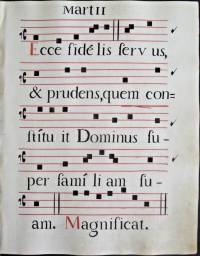
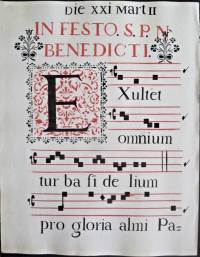 Leaf, c. 1750 Antiphonary. Latin. Italian Scriptorium, 14.3" x 18.2" ($23.00)
Leaf, c. 1750 Antiphonary. Latin. Italian Scriptorium, 14.3" x 18.2" ($23.00)An Antiphonary is one of the books used by a liturgical choir for chanting or singing parts of the Roman Catholic liturgy. In addition to traditional Gregorian chants, it also includes hymns, introits, responsories, versicles, responses, psalms, and so forth. This was the chant for March 21.
Hand written on heavy, watermarked paper. Has a 4-bar staff with an eight-note musical range, typical of most Gregorian chants). Notes, words, and decoration in black and red. A rather unskillful job with letters not uniform and out of alignment, smudges, and varying thickness lines.
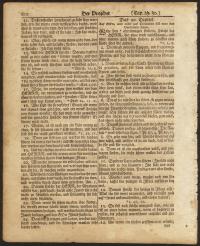
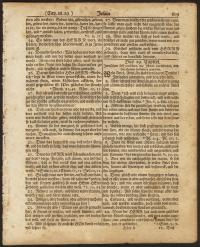 Leaf, 1776 Saur “Gun Wad” Bible, German, Isaiah 28:13 - 30:13. Printed by Christoph Saur, Germantown, Pennsylvania. 225 x 156, 7.9" x 9.8" ($15.00)
Leaf, 1776 Saur “Gun Wad” Bible, German, Isaiah 28:13 - 30:13. Printed by Christoph Saur, Germantown, Pennsylvania. 225 x 156, 7.9" x 9.8" ($15.00)Each of the three printings of Martin Luther’s German Bible by Christoph Saur and his son was a first. The first printing of 1,200 copies in 1743 was the first European-language Bible printed in America because the British insisted that English Bibles be imported from the mother country. (The first Bible of any kind printed in America was in an Algonquin dialect.) It took nearly 20 years for the first printing of Saur’s Bible to sell out.
The second printing in 1763 by Christoph’s son, also named Christoph, was the first Bible printed on American-made paper.
The third printing in 1776 was the first Bible printed with American-made type. Legends (generally discredited today) have it that sheets from this third printing were ready for the binder when British soldiers invaded Germantown and used the pages as bedding for their horses and to make cartridges for their guns, thus giving it the nick name “The Gun Wad Bible.” Also that Christoph’s daughter, Catherine, managed to save only ten copies for her family. In truth, unbound sets of sheets of this printing were sold at public auction in 1778 and were mostly bound up and sold to the public in the subsequent few years.
Because he was a pacifist, Christoph Saur refused to take an oath of allegiance to the new state of Pennsylvania. He was arrested and tried, and his property, including his printing shop, was seized and sold at auction.
Quarto size page printed in 12-point German Black Letter type, double columns tight to a center rule, 52 lines. Scripture references interspersed in the text.
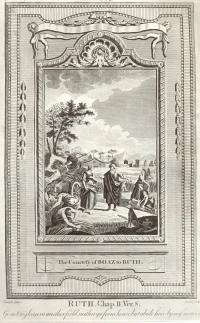 Illustration, 1782 The Complete British Family Bible, Ruth 2:8, Vandyke Engraving. Printed for A. Hogg, London. 9.6" x 15.3" ($3.78)
Illustration, 1782 The Complete British Family Bible, Ruth 2:8, Vandyke Engraving. Printed for A. Hogg, London. 9.6" x 15.3" ($3.78)This illustration was “Engraved for The Rev. Dr. Wright’s Complete British Family Bible,” a KJV with extensive exposition and commentary by Paul Wright. Herbert’s catalog notes that “another edition was published in 1800? with the title The Christian’s New and Complete British Family Bible.” This leaf has a large copper plate engraving by Vandyke titled “The Courtesy of Boaz to Ruth” based on the scripture of Ruth 2:8, “Go not to glean in another field, neither go from hence, but abide here by my maidens.”
This poorly-centered single-sided engraving was probably printed separately from the Bible and tipped in by the bookseller or purchaser. [Herbert 1278]
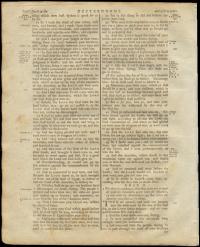
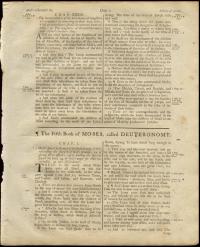 Leaf, 1791 KJV Bible, Numbers 36:1 - Deut 2:4. (plus 3 additional pages from Deuteronomy) Printed by Isaac Collins, Trenton, NJ. 246 x 175, 8.5" x 10.5" ($12.50 each page)
Leaf, 1791 KJV Bible, Numbers 36:1 - Deut 2:4. (plus 3 additional pages from Deuteronomy) Printed by Isaac Collins, Trenton, NJ. 246 x 175, 8.5" x 10.5" ($12.50 each page)Bible printing began in Trenton in 1788, when Isaac Collins, a Quaker, published a New Testament. In 1789 he issued a proposal to publish the whole Bible if he received 3,000 subscriptions. The undertaking was endorsed by the governor, William Livingston, as well as the Quaker, Presbyterian, Episcopal, and Baptist churches. It was eventually published in 1791 in an edition of 5,000 copies.
Instead of the usual dedication to King James, the Bible had an address “To The Reader” by the Rev. Dr. Witherspoon, which was reprinted in many later American Bibles.
Collins took unusual care to prevent printer's mistakes with committees appointed to correct the proofs. In addition, the proofs were read 11 times by Collins' children. It is said that only two errors were ever found after publication—one a broken letter, the other a punctuation mark. This accurate text served as a standard of correctness for many later printers.
Bible is quarto size, printed in Roman 10-point type, double columns, 65 lines, with side scripture references in small 6-pt type. [Herbert 1354]
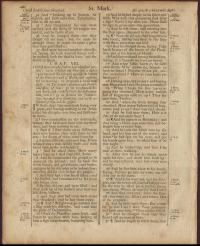
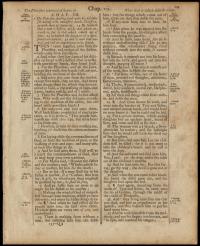 Leaf, 1791 KJV Bible, Mark 7:34 - 8:31. Printed by Isaiah Thomas, Worcester, Mass. 200 x 192, 9.2" x 11.5" ($10.29)
Leaf, 1791 KJV Bible, Mark 7:34 - 8:31. Printed by Isaiah Thomas, Worcester, Mass. 200 x 192, 9.2" x 11.5" ($10.29)Isaiah Thomas, whom Benjamin Franklin called “the Baskerville of America,” was one of the notable publishers during the early days of the nation. He made every effort to insure accuracy of the Biblical text by comparing some 30 different editions and having the text carefully examined by several clergymen and others. Thomas was also a famous painter and patriot, publisher of Massachusetts Spy. During the war, he was forced to move from Boston to Worcester.
The New Testament published by Robert Aitken in Philadelphia in 1777 and entire Bible in 1782 were the first Bibles printed in America. Two more were printed in Philadelphia in 1790 by Carey, Stewart & Co.(Catholic) and William Young (KJV), which, along with a quarto edition by Isaac Collins in Trenton, New Jersey in 1791 and both folio and quarto-size Bibles by Isaiah Thomas really got Bible publishing in America off the ground.
Bible is in two volumes, folio size, printed in Roman 12-point type, double columns, 60 lines, with side scripture references in small 7-pt type. [Herbert 1356]
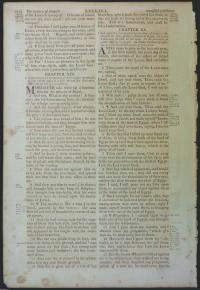
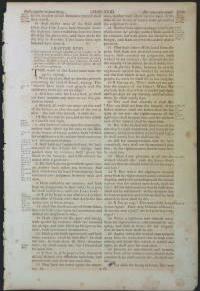 Leaf, 1801 KJV Bible, Ezekiel 17:24 - 20:13, page 623-24. Printed for William Durrell. by George F. Hopkins, New York. 314 x 202, 9.4” x 13.8" ($5.00)
Leaf, 1801 KJV Bible, Ezekiel 17:24 - 20:13, page 623-24. Printed for William Durrell. by George F. Hopkins, New York. 314 x 202, 9.4” x 13.8" ($5.00)Although the first printing press was in operation in the Massachusetts colony in 1638, the earliest American edition of the Bible in English was printed by Robert Aitken in Philadelphia in 1782. Before this several proposals had been made among the fifty-odd American printing shops to print a native edition of the Bible, in spite of exclusive patents granted to British printers by the Crown. None succeeded, the plans failing to interest sufficient subscribers or to secure an adequate supply of paper and type for the project. By the time this large folio version for Durrell, a paper merchant, appeared in New York, improvements in printing and paper making had finally made native production possible, though most Bibles printed in America for decades to come would be “pocket sized” or small quarto format.
Folio size printed in 12-pt Roman type, double columns, 65 lines, side scripture references in tiny 6-pt type. This is one of the rarest Bibles printed in the U.S. [EELBV AVV-103400, Hills 76, not in Herbert]
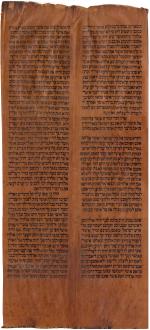 Section, Torah scroll, c. 1800s, Deuteronomy 28:62 - 30:8, Hand lettered on deer parchment, from Yemen, 21.3" x 9.8" ($37.00)
Section, Torah scroll, c. 1800s, Deuteronomy 28:62 - 30:8, Hand lettered on deer parchment, from Yemen, 21.3" x 9.8" ($37.00)This scroll covers Repentance and Restoration, The Covenant Renewed, The Covenant, and Moses’ Final Discourse. It is very neatly hand-written in the original Hebrew Language
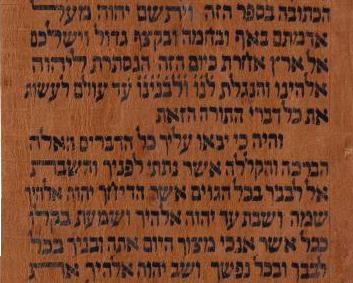 on deer parchment and is approximately 150-250 years old. From Yemen, this type of scroll is prized for the beauty of its soft deer parchment and its beautiful writing. The warm reddish color is due to the original color becoming deeper over the centuries. Scrolls of this age are quite rare and seldom seen in synagogues today. It is a witness to the Yemenite Jewish custom of continuing to preserve the Torah on hand-written scrolls.
on deer parchment and is approximately 150-250 years old. From Yemen, this type of scroll is prized for the beauty of its soft deer parchment and its beautiful writing. The warm reddish color is due to the original color becoming deeper over the centuries. Scrolls of this age are quite rare and seldom seen in synagogues today. It is a witness to the Yemenite Jewish custom of continuing to preserve the Torah on hand-written scrolls.
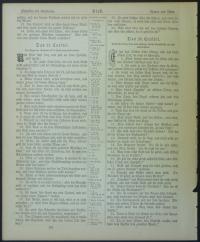
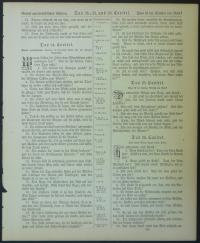 Leaf, c. 1800's German Bible, Job 23:15 - 28:25, page 391-92. 265 x 196, 9.3" x 11.4" ($1.00) [Also leaf of Numbers 17:6 - 20:1, page 123-24 and 2 Kings 4:42 - 6:33, page 285-86.]
Leaf, c. 1800's German Bible, Job 23:15 - 28:25, page 391-92. 265 x 196, 9.3" x 11.4" ($1.00) [Also leaf of Numbers 17:6 - 20:1, page 123-24 and 2 Kings 4:42 - 6:33, page 285-86.]By the 1800s, German Bibles were printed outside of Germany in many German colonies and settlements, but principally in America. In fact, the first Bible printed in America in 1743 was the German Saur Bible because English Bibles were one of the things the British insisted be imported from the mother country.
Without a title page it is quite impossible to know where a Bible originated or its printing date so all we can say is that this is an attractive page from a quarto-size German Bible.
Two columns of finely printed black letter type flank a narrow center column with scripture cross references. Elaborate initial capitals start each chapter. Some are hand-colored in red.
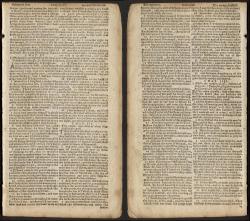 Leaf, early 1800's English pocket Bible, Nehemiah 1:9 - 4:10. Probably printed by Sir D. Hunter Blair and J. Bruce, Edinburgh. 3.0" x 5.2" ($1.00)
Leaf, early 1800's English pocket Bible, Nehemiah 1:9 - 4:10. Probably printed by Sir D. Hunter Blair and J. Bruce, Edinburgh. 3.0" x 5.2" ($1.00)A Soldier’s Pocket Bible was first issued in 1643 to Cromwell’s army and was put in general use among his soldiers. However, this was hardly a complete Bible but rather a condensed pamphlet version with just 16 pages measuring 5.4" x 3.1", about the size of a passport. It contained 150 scripture verses from the Geneva Bible, all related to fighting and war. Mostly from the Old Testament, the verses were intended to inspire the morale of Cromwell’s troops.
Over the years, various pocket Bibles were produced for servicemen but they also gained popularity among the general public in the 1800s and early 1900s. Today, smart phones and various electronic devices have largely replaced printed pocket Bibles.
This particular pocket-size Bible was produced in 5 printings between 1809 and 1827 by Sir D. Hunter Blair and J. Bruce, Edinburgh. It has two extremely closely spaced columns 1.2" wide of 77 lines in minuscule 4.5-point Roman type. The entire Bible would have had approx. 800 pages, many fewer than a typical octavo-size Bible. [Herbert 1525, 1599, 1623, 1751, 1764]
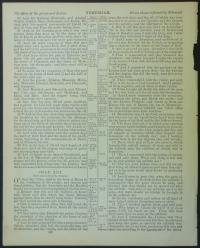
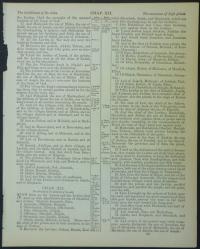 Leaf, 1860 King James Bible, Nehemiah 11:17 - 13:22, page 331-32. Printed by John E. Potter, Philadelphia. 266 x 205, 9.3" x 11.6" ($4.00)
Leaf, 1860 King James Bible, Nehemiah 11:17 - 13:22, page 331-32. Printed by John E. Potter, Philadelphia. 266 x 205, 9.3" x 11.6" ($4.00)KJV “Family” Bibles in several large folio and quarto sizes were printed by the John E. Potter firm from approx 1850 to 1890. They have heavy embossed covers with various designs in gold gilt on brown leather. Bible includes Old and New Testaments, Apocrypha, Psalms of David in Metre, Concordance, four tables, detailed index, and several appendices. Also has engraved illustrations by Gustave Dore and others.
All of the text sections of the John Potter and William Harding Bibles are identical (printed from the same plates). The Bibles differ only in illustrations, paper stock (Potter is on heavier paper 1/10" taller), and embossing on cover.
Quarto size, 11-point Roman type, double columns, 69 lines per column. Tiny 6-pt scripture references run down center of page. [Not in Herbert]
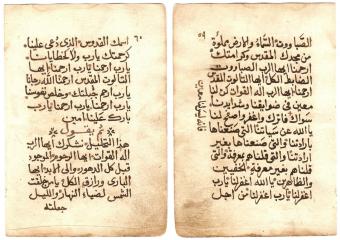 Leaf, Agpeya Prayer book manuscript, classic Arabic. Handwritten. Undated but probably 150+ years old. 4.3" x 5.9" ($13.00)
Leaf, Agpeya Prayer book manuscript, classic Arabic. Handwritten. Undated but probably 150+ years old. 4.3" x 5.9" ($13.00)The prayer book of the Orthodox Coptic Church is known as the Agpeya, which actually means the “Book of Hours.” It contains prayers for seven different hours to be said throughout the day. The hours, starting at sunrise and ending at sunset, are chronologically laid out, each containing a theme corresponding to events in the life of Jesus. Each prayer hour is composed of an introduction which includes the Lord’s Prayer, the Prayer of Thanksgiving, and Psalm 50. This is followed by various Psalms, an excerpt from the Holy Gospel, and Litanies
The Agpeya also includes prayers to be said before confession, before and after communion, before and after dining, before and after studying, and prayers for a good husband or wife.
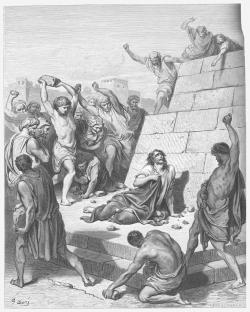 Illustration, 1884 Dore Gallery of Bible Stories, the stoning of Stephen (Acts 8:57-60), Page 389-90. 8.1" x 10.7" ($1.00)
Illustration, 1884 Dore Gallery of Bible Stories, the stoning of Stephen (Acts 8:57-60), Page 389-90. 8.1" x 10.7" ($1.00)This illustration originally appeared in The Holy Bible, with Illustrations by Gustave Dore published by Cassell, Petter, and Galpin in London and New York around 1866.
Nowhere but in the Bible were dramatic textual material and the artistry of Gustave Dore (1832-1883) more perfectly matched. The Bible seemed to unleash a new power of creation in Dore not apparent in his previous work. He expressed it all: the creation, horrifying visions of the flood, battle sequences with their monumental crowds, the parables, and scenes depicting the life of Jesus. In all, Dore executed 241 engravings, all of which were accompanied by one or more verses from the La Sainte Bible. Dore's engravings were published in many books and formats in France, Germany, and England.
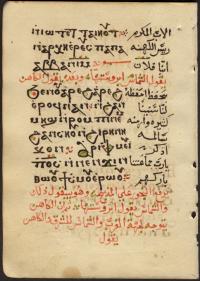
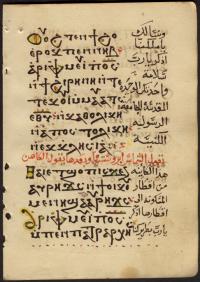 Leaf, 1898 Coptic Euchologion, Coptic and Arabic. Produced in al-Kosheh, Egypt. 140 x 85, 4.7" x 6.7" ($17.00)
Leaf, 1898 Coptic Euchologion, Coptic and Arabic. Produced in al-Kosheh, Egypt. 140 x 85, 4.7" x 6.7" ($17.00)This is a very rare Coptic leaf taken from manuscript dated 1614 Coptic year (1898 AD). It represents the Coptic Euchologion, containing the Raising of Incense Service and the Liturgy of St. Basil. The owner was a priest from a long line of priests in his family (Abdul-Masih Bin Gabriel Bin John Bin Botros Bin Abdul-Nour Bin Gabriel). He served in the Church of Archangel Michael in a the trading village of al-Kosheh in southern Egypt. The village became infamous for a massacre of 20 Coptic Christians by Muslims on Sunday, January 2, 2000. 89 suspects were arrested but released the next day and all charges were dropped. The Coptic Christians killed in this incident were considered martyrs of the Coptic Orthodox Church by Pope Shenouda III.
Duodecimal size leaf, hand lettered in 2 poorly-defined columns with large Coptic lettering on the left and smaller Arabic lettering on the right. Some lines are in red and it has red and yellow rubication.
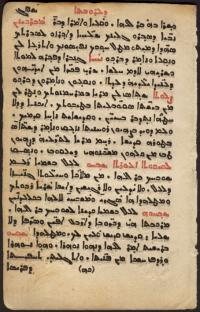
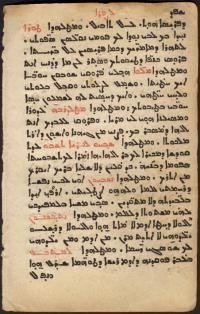 Leaf, 1904 Maronite Aahama, Syriac. Printed by the Catholic Church, Rome. 153 x 93, 4.4" x 7.0" ($20.00)
Leaf, 1904 Maronite Aahama, Syriac. Printed by the Catholic Church, Rome. 153 x 93, 4.4" x 7.0" ($20.00)Maron, a fourth-century monk, spent his entire life on a mountain in Syria. Today Saint Maron is considered the “father” of the spiritual and monastic movement called the Maronite Church. This movement has had a profound influence in Lebanon, and to a lesser degree in modern-day Syria, Jordan, and Palestine.
The Maronite Aahama (or Anaphora) is a book of the Roman Catholic Maronite Tradition obligatory weekly prayers.
Printed on this well-preserved duodecimal size leaf is a poorly centered single column of 22 lines of roughly 12-point black type with a few words in red.
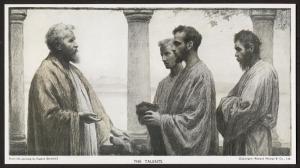 Illustration, 1908 book, The Parables by Eugène Burnand, English edition, Parable, “The Talents.” Published by Richard Wyman & Co., London. 9.6" x 5.2" ($4.00)
Illustration, 1908 book, The Parables by Eugène Burnand, English edition, Parable, “The Talents.” Published by Richard Wyman & Co., London. 9.6" x 5.2" ($4.00)Eugène Burnand (1850–1921) was a prolific painter and illustrator from Moudon, Switzerland. He studied art in Geneva and Paris, traveled widely, then settled in Versailles. His later years were spent in Paris where he died a celebrated and well respected artist both in Switzerland and France. He was primarily a realist painter of nature. A deeply religious man, his Protestant beliefs led him to include more religious works on which he put his stamp of realism. He became best known in Europe for his illustrations for The Parables, a book published in French, German and English over four decades. With each illustration is an in-depth description of the meaning of the parable.

|